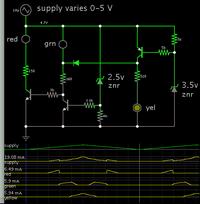nguyenvanthien
Member level 4

hi all,
I studied lots of circuit's forms to 3.7V battery indicator. However, they always have disadvantage: waste power.
So, I'd like save power by way: voltage <3.2 : only red led on; >4.2V: only green led on; from 3.2 to 4.2V; circuit doesn't operate > ultra low current- ultra low power. Give me any idea! thanks
I studied lots of circuit's forms to 3.7V battery indicator. However, they always have disadvantage: waste power.
So, I'd like save power by way: voltage <3.2 : only red led on; >4.2V: only green led on; from 3.2 to 4.2V; circuit doesn't operate > ultra low current- ultra low power. Give me any idea! thanks




